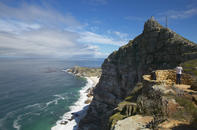From Below the Sea
Cape Point stands like a great big dot at the bottom of a massive exclamation mark, at the bottom left-hand corner of the continent, and it is eclipsed as a geographical icon only by Table Mountain, at the top end of the punctuation mark.

No matter which way you look at it, just thinking about Cape Point can be an evocative, emotional experience. The very best way to see it is like the ancient mariners did - from the sea below. If you don't have your own boat, join any of the number of pelagic bird and shark-viewing trips that go that way (depending on your likes).
Earthly Paradise

Cape Town and Table Mountain are among the most fashionable tourist destinations in the Western Cape. Cape Point should be added to that grouping, standing as it does like a defiant exclamation mark at the southwestern tip of the African continent. When a southeaster is roaring and swells and wind-maddened spume batter that prow-like promontory, and cormorants wheel clumsily about in the roaring wind, you feel sensationally elemental.
You can imagine that if the weather would clear you could see all the way to the Antarctic. Or maybe spot the Flying Dutchman, fated to try forever to steer a course around the stormy Cape. For sailors wind has always defined the experience of arriving in Table Bay and rounding Cape Point, but it is the one thing the tourism literature will not tell you about.
Sure, lots of places are windy, but this one can get-very windy, A good day in Cape Town is like a glass of crisp Chablis, a bad one like a box of Chateau Plonk. For most of winter (May to October) a cold, blustery northwestern brings driving rain, sometimes for days at a time.
But in-between these anti-cyclonic cold fronts lie days so perfect you are led to believe you have woken in some kind of earthly paradise. For much of summer, a dry, searing southeaster blows away the blues, and blows away anything else left lying about. Locals call the Mind the Cape Doctor, because it scrubs up the atmosphere.
 If you have only a day or two in Cape Town on your South African holiday, this self-drive route around the Cape to Cape Point covers the gre...
If you have only a day or two in Cape Town on your South African holiday, this self-drive route around the Cape to Cape Point covers the gre...